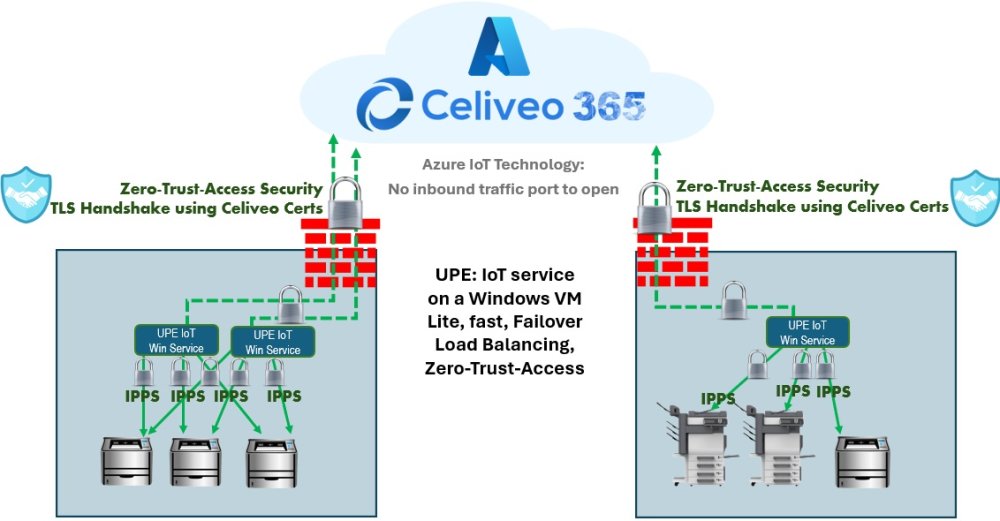Network printers that don’t support the Celiveo 365 embedded agent can still be used for print jobs release, if they fully support the IPP 2.0 protocol.
That high-security service is provided through the installation of a Windows service on the network, that uses the Microsoft Azure IoT service.
That’s the Celiveo 365 UPE, Universal Printer Endpoint service, it can be installed in a Windows VM, and can handle up to 500 simultaneous print requests per installed instance.
To learn how to generate and install a UPE package click here.
When an encrypted print job needs to be pulled from the Cloud, decrypted and pushed to a printer, Azure communicates an IoT instruction to the UPE the closest to the printer.
Multiple UPE can be deployed in your company, each printer must be reachable on the network by at least one UPE.
- Each UPE uses the 5 tags to define its printer access scope, those are defined in the WebAdmin portal, virtual printer creation and management
- Each printer can have up to 5 tags defined, those are defined in the WebAdmin portal, physical printer add and manage
NFC Tap & Print
The UPE makes it possible to use the Tap & Print mode, with NFC tags.
More information here.
UPE deployment example:
You have multiple sites in the US (Texas, California), Canada (Quebec, Ontario), Europe (Germany, UK), Asia (Singapore, Japan).
There are various options to deploy the UPE:
- One single UPE instance with all tags set to the * wildcard value, if all printers are reachable from the network where the UPE service is installed
Pros: simple and just one UPE to deploy
Cons: all printers need to be reachable from the network where UPE is installed
- One UPE per continent
Pros: simple and just one UPE to deploy per continent
Cons: all region printers need to be reachable from the regional networks where UPE are installed some countries may need some higher bandwidth in a continent
- One UPE per country
Pros: Allows to support local bandwidth need and isolated networks
Cons: One UPE to install per isolated network
- Two or more UPE per country or continent with very high number of printers
Pros: Provides load balancing and failover service
Zero-Trust-Access security
Each UPE instance uses an ECC-P256 certificate chain identifying the subscription and the IoT endpoint to connect to the Cloud and establish the TLS communication.
It means there is no credentials that could become compromised, there is no endpoint that could be hacked with brute force attacks.
The Celiveo UPE and print tracking
The Celiveo UPE provides tracking service, it tracks fpr each print job the user UPN, the print job name, the printer information and actual number of pages produced by the printer. That information is sent to the Cloud where it is used by the Power-BI reporting.




Post your comment on this topic.